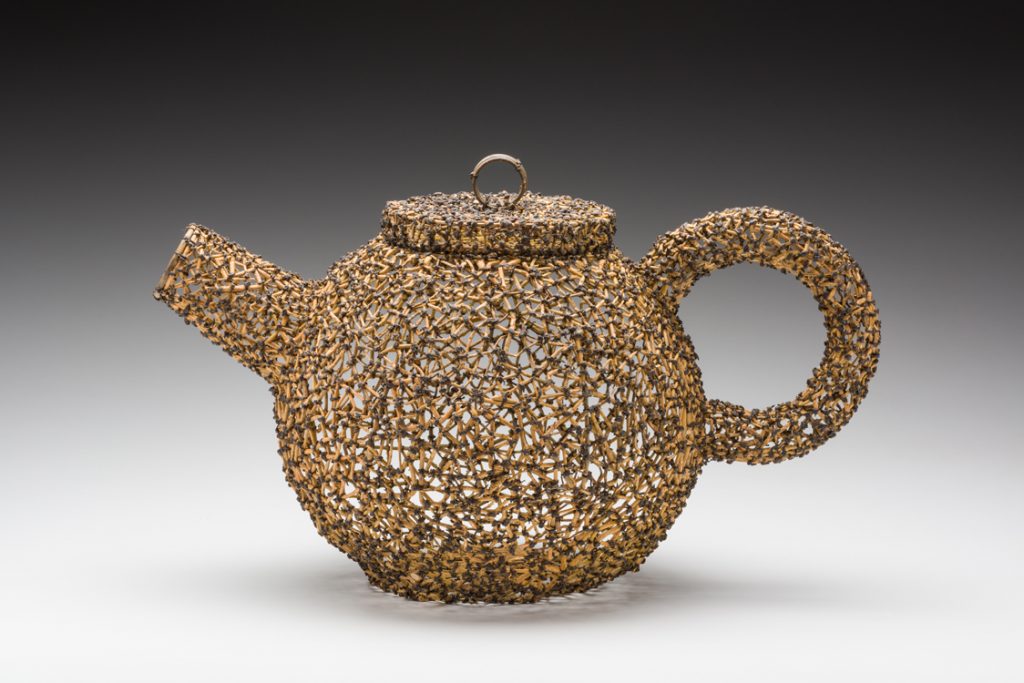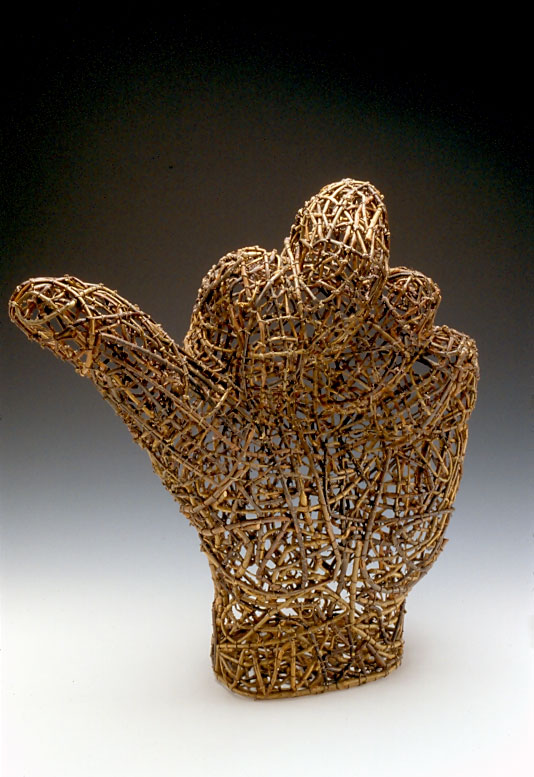“Baskets. Even the word seems humble, self-effacing, and traditional…No one expects a concert of contemporary music to sound like Bach, or a contemporary painting to look like a Leonardo. Strange, then, that many expect contemporary baskets to be just like baskets of another century.”[i]
John McQueen (American, b. 1943) is known for his complex sculptural baskets that utilize an array of natural resources that he personally “selects, gathers, and prepares” for construction.[ii] These materials, which range from burs and twigs to vines and bark, are used not only to emphasize the connections between humans and nature, but to also explore issues involving form, language, and containment. McQueen’s diverse body of work “hover[s], often with great humor, in the gap between craft, sculpture, and conceptual art.”[iii] For basketry, however, his contributions have been instrumental in redefining the discipline and developing a new contemporary aesthetic.
EARLY YEARS
McQueen was born in Oakland, Illinois, but around the age of ten his family moved to Fort Lauderdale, Florida. At that time, the Sunshine State had “something wild and uncivilized about it.”[iv] McQueen was aware of the “abundant vegetation” surrounding him, but instead of exploring nature, he primarily focused on mechanical objects in his youth.[v] This was an interest that he inherited from his father who was a licensed mechanic for the airline industry. In fact, McQueen “connects” his basket making “with [his] father building planes, fitting parts together.”[vi] He believes “it is a type of construction or building [he] got through osmosis.”[vii]
McQueen’s mother, on the other hand, introduced him to art and “encouraged” his creative activities.[viii] In 1971 he earned a Bachelor of Art degree with a focus on sculpture from the University of South Florida in Tampa. During this period, McQueen often worked with living materials such as sod or adobe and his sculptures explored concepts such as how “man uses trees as metaphors for himself in nature.”[ix] Coincidentally, this was where McQueen was artistically, right before his transition to baskets.[x]
After graduating, McQueen longed for “a new perspective.”[xi] He found that in New Mexico. While living there, he “was drawn to the Native American reservations” and on one occasion he witnessed “a basket maker weaving a basket large enough for him to sit inside as he worked up the walls.”[xii] “[McQueen] was startled by its beauty and simplicity.”[xiii] In addition, “the scale of this form was mesmerizing. [He] wanted to replicate [this] accomplishment.”[xiv] McQueen initially explored the mechanics of these woven constructions on his own. However, his immense curiosity eventually led him to seek further instruction at Tyler School of Art at Temple University in Philadelphia, Pennsylvania. McQueen entered the textile program there and received a Master of Fine Arts in 1975.
MCQUEEN’S BASKETRY
In the 1970s, when McQueen started making baskets, many American fiber artists were investigating a variety of materials, forms, and techniques. At the forefront of this rapidly changing field was the fiber artist Ed Rossbach. In 1973 Rossbach published his first book, Baskets as Textile Art which looked at traditional and contemporary approaches to the art form. McQueen credits Rossbach and this publication as being influential, especially in the early days of his career.
In 1977 McQueen “outlined the essential characteristics of a basket” in his journal.[xv] After defining “this ideal basket,” “he ran from its constraints.”[xvi] McQueen would eventually “explore, change, enlarge, and contradict every one of these attributes.”[xvii] In the process he has investigated subjects such as the nature of containment, delved into abstraction, explored the written word, which can range “from witty to wise,” and he has created figurative works that examine body language such as “posture, tension, and gesture.”[xviii] In addition, McQueen has not been afraid to embrace a range of materials or combine natural and contemporary industrial elements such as staples or plastic rivets. In early 1990s McQueen’s structures increased in scale and some works in more recent years have “entered the realm of large-scale sculpture and installation art.”[xix] His roots in sculpture never truly left him. In fact, McQueen has maintained a sculptor’s mindset throughout his career. However, he believes “his work is part of the basket tradition, no matter how far [he] push[es] to the edge of its traditional definition.”[xx]
KAMM COLLECTION
There are two McQueen works within the Kamm Collection: Teaser-Vice (1999) and Teapot (2010). Teaser-Vice is an open weave sculpture made from wooden twigs tied with string. In McQueen’s distinctive style he fashioned a human hand cut off at the wrist. The fingers are curled inward, with the middle finger’s knuckle higher than the others, and the thumb extended. The general shape makes a reference to a teapot. The Kamms commissioned this teapot-inspired work for the collection, and this was McQueen’s clever interpretation of a form that he does not normally create.
The second McQueen work, Teapot, is made of willow sticks tied together with waxed thread. It has a precisely constructed spherical body with a loop handle, tubular spout, disk shaped lid, and circular finial. It was acquired by the Kamms from the 2010 invitational exhibition Teapot Redefined at Mobilia Gallery in Cambridge, Massachusetts. Unlike Teaser-Vice, this is a straightforward interpretation of the teapot form. McQueen approaches the work in his usual manner. With great technical skill and a sensitivity to materials, he intricately weaves together this construction which ultimately only holds or separates space.
It is important to note that these two McQueen works, like the rest of his oeuvre, “are the physical manifestation of his response to nature.”[xxi] While the natural materials McQueen collects can inspire a form, the different aspects of that material can also “carry meaning.”[xxii] In particular, he feels a “bond with the trees” and he sees his baskets as “trees rearranged.”[xxiii] McQueen thinks that humans “see trees as a symbol of nature, both good and bad. We feel we have to control them, prune them, and thin them out…It is our way of being in charge of the world.”[xxiv] Ultimately, John McQueen “believes that trees speak for our longing for organization, order, and completeness – the very qualities that so remarkably characterize his baskets.”[xxv]
Further Reading/Viewing:
Buhler-Maki, Susan, Lisa Englander, Elizabeth Frozena, Laura Grayson, and Lena Vigna. Collection Focus: John McQueen at RAM. Racine, WA: Racine Art Museum, 2010.
Clark, Garth. The Artful Teapot. London: Thames & Hudson, 2001.
John McQueen. Art + Identity: An International View. Brown Grotta Arts. 15 April 2019.
Lønning, Kari. The Art of Basketry. New York, NY: Sterling Publishing Co., 2000.
McQueen, John, Vicki Halper, and Ed Rossbach. John McQueen: The Language of Containment. Washington, DC: Renwick Gallery, National Museum of American Art, Smithsonian Institution, 1991.
Pulleyn, Rob. The Basketmaker’s Art: Contemporary Baskets and Their Makers. Asheville, NC: Lark Books, 1986.
Notes:


